摘要: Pandas数据规整相关的学习笔记,记录了《利用python进行数据分析》学习过程和笔记。
清理、转换、合并、重塑
1 合并数据集
pandas有一些内置的合并数据集方法:
- pandas.merge:根据一个或多个键将多个DataFrame连接起来,类似数据库连接;
- pandas.concat:可以沿着一个轴将多个对象堆叠起来;
- 实例方法combine_first可以将重复数据编制在一起,用以填充另一个对象的缺失值。
1.1 数据库风格的DataFrame合并
数据库合并(merge)或连接(join)运行将一个或多个键将行链接起来。来个例子:
In [1]: import pandas as pd
In [2]: from pandas import Series,DataFrame
In [3]: df1 = DataFrame({'key':list('bbacaab'),'data1':range(7)})
In [4]: df2 = DataFrame({'key':list('abd'),'data2':range(3)})
In [5]: df1
Out[5]:
data1 key
0 0 b
1 1 b
2 2 a
3 3 c
4 4 a
5 5 a
6 6 b
In [6]: df2
Out[6]:
data2 key
0 0 a
1 1 b
2 2 d
# merge 合并数据集,相同列的共同值。
In [7]: pd.merge(df1, df2) #不指定列名,默认会选择列名相同的key列。
Out[7]:
data1 key data2
0 0 b 1
1 1 b 1
2 6 b 1
3 2 a 0
4 4 a 0
5 5 a 0
In [8]: pd.merge(df1, df2, on='key') # 指定列名
Out[8]:
data1 key data2
0 0 b 1
1 1 b 1
2 6 b 1
3 2 a 0
4 4 a 0
5 5 a 0
# 可以将不同列名进行链接。
In [9]: df3 = DataFrame({'lkey':list('bbacaab'),'data1':range(7)})
In [10]: df4 = DataFrame({'rkey':list('abd'),'data2':range(3)})
In [11]: pd.merge(df3,df4,left_on='lkey',right_on='rkey')
Out[11]:
data1 lkey data2 rkey
0 0 b 1 b
1 1 b 1 b
2 6 b 1 b
3 2 a 0 a
4 4 a 0 a
5 5 a 0 a
# 默认inner,通过how可以指定outer
In [12]: pd.merge(df1,df2,how='outer')
Out[12]:
data1 key data2
0 0.0 b 1.0
1 1.0 b 1.0
2 6.0 b 1.0
3 2.0 a 0.0
4 4.0 a 0.0
5 5.0 a 0.0
6 3.0 c NaN
7 NaN d 2.0
In [13]: pd.merge(df1,df2,how='left')
Out[13]:
data1 key data2
0 0 b 1.0
1 1 b 1.0
2 2 a 0.0
3 3 c NaN
4 4 a 0.0
5 5 a 0.0
6 6 b 1.0
In [14]: pd.merge(df1,df2,how='right',on='key')
Out[14]:
data1 key data2
0 0.0 b 1
1 1.0 b 1
2 6.0 b 1
3 2.0 a 0
4 4.0 a 0
5 5.0 a 0
6 NaN d 2
# 多个键 合并
In [15]: left = DataFrame({'key1':['foo','foo','bar'],'key2':['one','two','one']
...: ,'lval':[1,2,3]})
In [16]: right = DataFrame({'key1':['foo','foo','bar','bar'],'key2':['one','one'
...: ,'one','two'],'rval':[4,5,6,7]})
In [17]: pd.merge(left,right,on=['key1','key2'],how='outer')
Out[17]:
key1 key2 lval rval
0 foo one 1.0 4.0
1 foo one 1.0 5.0
2 foo two 2.0 NaN
3 bar one 3.0 6.0
4 bar two NaN 7.0
# 如果使用的on选项后,还有重复列名,怎么办?
# merge有一个suffixes选项,可以处理重复列名
In [18]: pd.merge(left,right,on='key1')
Out[18]:
key1 key2_x lval key2_y rval
0 foo one 1 one 4
1 foo one 1 one 5
2 foo two 2 one 4
3 foo two 2 one 5
4 bar one 3 one 6
5 bar one 3 two 7
In [19]: pd.merge(left,right,on='key1',suffixes=('_left','_right'))
Out[19]:
key1 key2_left lval key2_right rval
0 foo one 1 one 4
1 foo one 1 one 5
2 foo two 2 one 4
3 foo two 2 one 5
4 bar one 3 one 6
5 bar one 3 two 7
merge选项:

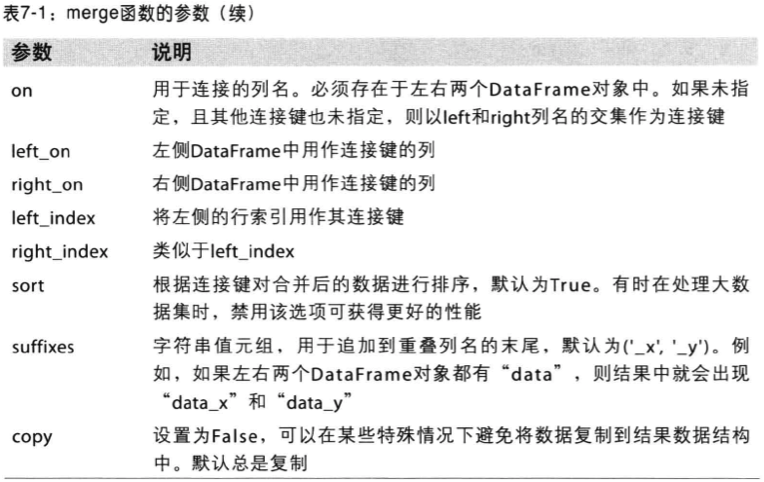
1.2 索引上的合并
传入left_index=True或者right_index=True,可以将索引作为链接键使用。
In [20]: left1 = DataFrame({'key':list('abaabc'),'value':range(6)})
In [21]: left2 = DataFrame({'group_val':[3.5,7]},index=['a','b'])
In [22]: left1
Out[22]:
key value
0 a 0
1 b 1
2 a 2
3 a 3
4 b 4
5 c 5
In [23]: left2
Out[23]:
group_val
a 3.5
b 7.0
# 将右DataFrame的index作为链接键;
In [24]: pd.merge(left1, left2 ,left_on='key', right_index=True)
Out[24]:
key value group_val
0 a 0 3.5
2 a 2 3.5
3 a 3 3.5
1 b 1 7.0
4 b 4 7.0
In [25]: pd.merge(left1, left2 ,left_on='key', right_index=True, how='outer')
Out[25]:
key value group_val
0 a 0 3.5
2 a 2 3.5
3 a 3 3.5
1 b 1 7.0
4 b 4 7.0
5 c 5 NaN
# 对于层次化索引,比较复杂
In [28]: lefth = DataFrame({'key1':['Ohio','Ohio','Ohio','Nevada','Nevada'],'key
...: 2':[2000,2001,2002,2001,2002],'data':np.arange(5.)})
In [29]: righth = DataFrame(np.arange(12).reshape(6,2),index=[['Nevada','Nevada'
...: ,'Ohio','Ohio','Ohio','Ohio'],[2001,2000,2000,2000,2001,2002]],columns=
...: ['event1','event2'])
In [30]: lefth
Out[30]:
data key1 key2
0 0.0 Ohio 2000
1 1.0 Ohio 2001
2 2.0 Ohio 2002
3 3.0 Nevada 2001
4 4.0 Nevada 2002
In [31]: righth
Out[31]:
event1 event2
Nevada 2001 0 1
2000 2 3
Ohio 2000 4 5
2000 6 7
2001 8 9
2002 10 11
# 使用列表的形式,指明多个列作为合并键
In [32]: pd.merge(lefth, righth, left_on=['key1','key2'],right_index=True)
Out[32]:
data key1 key2 event1 event2
0 0.0 Ohio 2000 4 5
0 0.0 Ohio 2000 6 7
1 1.0 Ohio 2001 8 9
2 2.0 Ohio 2002 10 11
3 3.0 Nevada 2001 0 1
In [33]: pd.merge(lefth, righth, left_on=['key1','key2'],right_index=True, how='
...: outer')
Out[33]:
data key1 key2 event1 event2
0 0.0 Ohio 2000.0 4.0 5.0
0 0.0 Ohio 2000.0 6.0 7.0
1 1.0 Ohio 2001.0 8.0 9.0
2 2.0 Ohio 2002.0 10.0 11.0
3 3.0 Nevada 2001.0 0.0 1.0
4 4.0 Nevada 2002.0 NaN NaN
4 NaN Nevada 2000.0 2.0 3.0
In [34]: left2 = DataFrame([[1,2],[3,4],[5,6]],index=['a','c','e'],columns=['Ohi
...: o','Nevada'])
In [35]: right2 = DataFrame([[7,8],[9,10],[11,12],[13,14]],index=list('bcde'),co
...: lumns=['Missouri','Alabama'])
In [36]: left2
Out[36]:
Ohio Nevada
a 1 2
c 3 4
e 5 6
In [37]: right2
Out[37]:
Missouri Alabama
b 7 8
c 9 10
d 11 12
e 13 14
# 同时根据两边索引合并
In [38]: pd.merge(left2, right2, how='outer', left_index=True, right_index=True)
...:
Out[38]:
Ohio Nevada Missouri Alabama
a 1.0 2.0 NaN NaN
b NaN NaN 7.0 8.0
c 3.0 4.0 9.0 10.0
d NaN NaN 11.0 12.0
e 5.0 6.0 13.0 14.0
DataFrame还有join方法,更好的合并索引。
In [39]: left2.join(right2, how='outer')
Out[39]:
Ohio Nevada Missouri Alabama
a 1.0 2.0 NaN NaN
b NaN NaN 7.0 8.0
c 3.0 4.0 9.0 10.0
d NaN NaN 11.0 12.0
e 5.0 6.0 13.0 14.0
In [44]: right1
Out[44]:
group_val
a 3.5
b 7.0
In [45]: left1
Out[45]:
key value
0 a 0
1 b 1
2 a 2
3 a 3
4 b 4
5 c 5
# left1 使用key来合并,right1使用索引。
In [46]: left1.join(right1, on='key')
Out[46]:
key value group_val
0 a 0 3.5
1 b 1 7.0
2 a 2 3.5
3 a 3 3.5
4 b 4 7.0
5 c 5 NaN
# 对于简单的索引合并,可以在join传入一个DataFrame组。
In [47]: another = DataFrame([[7,8],[9,10],[11,12],[16,17]],index=list('acef'),c
...: olumns=['NewYork','Oregon'])
In [48]: left2.join([right2, another]) # 传入list
Out[48]:
Ohio Nevada Missouri Alabama NewYork Oregon
a 1 2 NaN NaN 7 8
c 3 4 9.0 10.0 9 10
e 5 6 13.0 14.0 11 12
In [50]: left2.join([right2, another],how='outer')
Out[50]:
Ohio Nevada Missouri Alabama NewYork Oregon
a 1.0 2.0 NaN NaN 7.0 8.0
b NaN NaN 7.0 8.0 NaN NaN
c 3.0 4.0 9.0 10.0 9.0 10.0
d NaN NaN 11.0 12.0 NaN NaN
e 5.0 6.0 13.0 14.0 11.0 12.0
f NaN NaN NaN NaN 16.0 17.0
concat函数也能实现类似功能,后面介绍。
1.3 轴向连接
这是另一种连接,也叫作:连接、绑定或堆叠。
# numpy的函数:concatenation
In [51]: arr = np.arange(12).reshape(3,4)
In [52]: np.concatenate([arr,arr],axis=1)
Out[52]:
array([[ 0, 1, 2, 3, 0, 1, 2, 3],
[ 4, 5, 6, 7, 4, 5, 6, 7],
[ 8, 9, 10, 11, 8, 9, 10, 11]])
In [53]: np.concatenate([arr,arr],axis=0)
Out[53]:
array([[ 0, 1, 2, 3],
[ 4, 5, 6, 7],
[ 8, 9, 10, 11],
[ 0, 1, 2, 3],
[ 4, 5, 6, 7],
[ 8, 9, 10, 11]])
对于pandas也能推广,
In [54]: s1 = Series([0,1],index=list('ab'))
In [55]: s2 = Series([2,3,4],index=list('cde'))
In [56]: s3 = Series([5,6],index=list('fg'))
In [57]: pd.concat([s1,s2,s3])
Out[57]:
a 0
b 1
c 2
d 3
e 4
f 5
g 6
dtype: int64
# 做一个DataFrame出来。
In [58]: pd.concat([s1,s2,s3],axis=1)
Out[58]:
0 1 2
a 0.0 NaN NaN
b 1.0 NaN NaN
c NaN 2.0 NaN
d NaN 3.0 NaN
e NaN 4.0 NaN
f NaN NaN 5.0
g NaN NaN 6.0
# 使用inner选项,求并集
In [59]: s4 = pd.concat([s1*5,s3])
In [60]: s4
Out[60]:
a 0
b 5
f 5
g 6
dtype: int64
In [61]: pd.concat([s1,s4],axis=1)
Out[61]:
0 1
a 0.0 0
b 1.0 5
f NaN 5
g NaN 6
In [62]: pd.concat([s1,s4],axis=1,join='inner')
Out[62]:
0 1
a 0 0
b 1 5
# 指定求那些索引的并集
In [63]: pd.concat([s1,s4],axis=1,join_axes=[list('acbe')])
Out[63]:
0 1
a 0.0 0.0
c NaN NaN
b 1.0 5.0
e NaN NaN
In [64]: pd.concat([s1,s4],axis=1,join_axes=[list('acbef')])
Out[64]:
0 1
a 0.0 0.0
c NaN NaN
b 1.0 5.0
e NaN NaN
f NaN 5.0
# 用keys创建一个自己的层次化索引
In [65]: result = pd.concat([s1,s2,s3],keys=['one','two','three'])
In [66]: result
Out[66]:
one a 0
b 1
two c 2
d 3
e 4
three f 5
g 6
dtype: int64
# 在axis=1轴上连接的话,keys就成了列
In [70]: result = pd.concat([s1,s2,s3],keys=['one','two','three'],axis=1)
In [71]: result
Out[71]:
one two three
a 0.0 NaN NaN
b 1.0 NaN NaN
c NaN 2.0 NaN
d NaN 3.0 NaN
e NaN 4.0 NaN
f NaN NaN 5.0
g NaN NaN 6.0
同样的逻辑,对DataFrame也是一样,
In [72]: df1 = DataFrame(np.arange(6).reshape(3,2),index=list('abc'),columns=['o
...: ne','two'])
In [73]: df2 = DataFrame(np.arange(4).reshape(2,2),index=list('ac'),columns=['th
...: ree','four'])
In [74]: pd.concat([df1,df2],axis=1,keys=['level1','level2'])
Out[74]:
level1 level2
one two three four
a 0 1 0.0 1.0
b 2 3 NaN NaN
c 4 5 2.0 3.0
In [75]: pd.concat([df1,df2],axis=1)
Out[75]:
one two three four
a 0 1 0.0 1.0
b 2 3 NaN NaN
c 4 5 2.0 3.0
In [76]: pd.concat([df1,df2])
Out[76]:
four one three two
a NaN 0.0 NaN 1.0
b NaN 2.0 NaN 3.0
c NaN 4.0 NaN 5.0
a 1.0 NaN 0.0 NaN
c 3.0 NaN 2.0 NaN
# 还可以传入字典
In [77]: pd.concat({'level1':df1,'level2':df2},axis=1)
Out[77]:
level1 level2
one two three four
a 0 1 0.0 1.0
b 2 3 NaN NaN
c 4 5 2.0 3.0
# 没用的索引怎么处理?
In [78]: df3 = DataFrame(np.random.randn(3,4),columns=list('abcd'))
In [79]: df4 = DataFrame(np.random.randn(2,3),columns=list('bda'))
## 产生新的一列索引,顺序从0开始
In [80]: pd.concat([df3,df4],ignore_index=True)
Out[80]:
a b c d
0 0.322805 -1.495024 0.971860 -0.904791
1 0.332766 -2.320841 -0.903456 0.026713
2 -0.163670 0.387144 -0.746927 -0.360291
3 -0.074411 -0.557447 NaN 0.704929
4 2.673221 -1.143143 NaN 0.592930
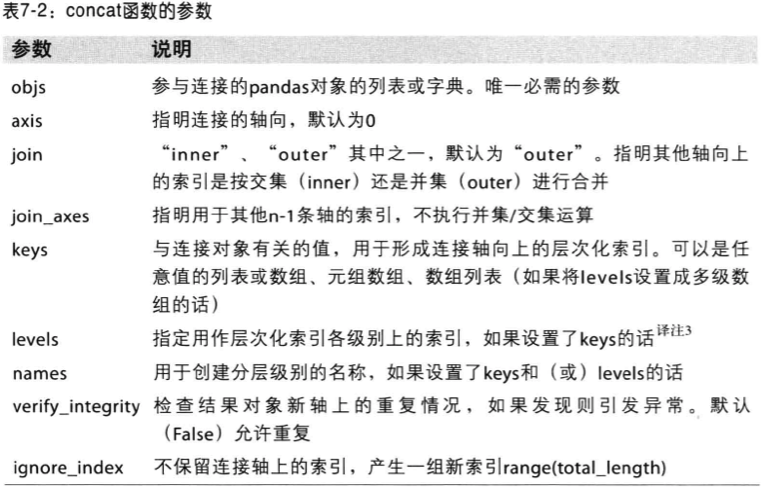
1.4 合并重叠数据
合并重叠数据不能使用merge和concat来实现,使用np.where函数。
In [81]: a = Series([np.nan,2.5,np.nan,3.5,4.5,np.nan],index=list('fedcba'))
In [85]: b = Series([0,1,2,3,4,np.nan],index=list('fedcba'))
In [86]: a
Out[86]:
f NaN
e 2.5
d NaN
c 3.5
b 4.5
a NaN
dtype: float64
In [87]: b
Out[87]:
f 0.0
e 1.0
d 2.0
c 3.0
b 4.0
a NaN
dtype: float64
# 实现如果a为空,就是用b
In [88]: np.where(pd.isnull(a), b, a)
Out[88]: array([ 0. , 2.5, 2. , 3.5, 4.5, nan])
# 相同的目标
In [95]: a.combine_first(b)
Out[95]:
f 0.0
e 2.5
d 2.0
c 3.5
b 4.5
a NaN
dtype: float64
针对DataFrame:
In [96]: df1 = DataFrame({'a':[1,np.nan,5,np.nan],'b':[np.nan,2,np.nan,6],'c':ra
...: nge(2,18,4)})
In [97]: df2 = DataFrame({'a':[5,4,np.nan,3,7],'b':[np.nan,3,4,6,8]})
In [98]: df1.combine_first(df2)
Out[98]:
a b c
0 1.0 NaN 2.0
1 4.0 2.0 6.0
2 5.0 4.0 10.0
3 3.0 6.0 14.0
4 7.0 8.0 NaN
2 重塑和轴向旋转
2.1 重塑层次化索引
针对DataFrame,有stack和unstack。stack将数据的列“旋转”为行,unstack反之。
In [6]: data = DataFrame(np.arange(6).reshape(2,3),index=pd.Index(['Ohio','Color
...: ado'], name='state'),columns=pd.Index(['one','two','three'],name='number
...: '))
In [7]: data
Out[7]:
number one two three
state
Ohio 0 1 2
Colorado 3 4 5
In [8]: data.stack() # 把列转化为行,即形成一个层次化索引的Series
Out[8]:
state number
Ohio one 0
two 1
three 2
Colorado one 3
two 4
three 5
dtype: int64
In [9]: data.stack().unstack() # 把层次化索引的Series转化为一个普通的DataFrame
Out[9]:
number one two three
state
Ohio 0 1 2
Colorado 3 4 5
In [10]: data.stack().unstack('number')
Out[10]:
number one two three
state
Ohio 0 1 2
Colorado 3 4 5
In [11]: data.stack().unstack(1)
Out[11]:
number one two three
state
Ohio 0 1 2
Colorado 3 4 5
In [12]: data.stack().unstack(0)
Out[12]:
state Ohio Colorado
number
one 0 3
two 1 4
three 2 5
In [13]: data.stack().unstack('state') # 选择指定的列,进行旋转
Out[13]:
state Ohio Colorado
number
one 0 3
two 1 4
three 2 5
对于Series也是一样,
In [14]: s1 = Series([0,1,2,3],index=list('abcd'))
In [15]: s2 = Series([4,5,6],index=list('cde'))
In [16]: data2 = pd.concat([s1,s2],keys=['one','two'])
In [17]: data2
Out[17]:
one a 0
b 1
c 2
d 3
two c 4
d 5
e 6
dtype: int64
In [18]: data2.unstack()
Out[18]:
a b c d e
one 0.0 1.0 2.0 3.0 NaN
two NaN NaN 4.0 5.0 6.0
In [19]: data2.unstack().stack() # 默认丢弃nan值
Out[19]:
one a 0.0
b 1.0
c 2.0
d 3.0
two c 4.0
d 5.0
e 6.0
dtype: float64
In [20]: data2.unstack().stack(dropna=False) # 不丢弃nan值
Out[20]:
one a 0.0
b 1.0
c 2.0
d 3.0
e NaN
two a NaN
b NaN
c 4.0
d 5.0
e 6.0
dtype: float64
2.2 将“长格式”转化为“宽格式”
时间序列的通常以“长格式”或“堆栈”格式存放在数据库或者CSV中。
In [28]: df = pd.DataFrame({'A' : ['one', 'one', 'two', 'three'] * 3,
...: 'B' : ['A', 'B', 'C'] * 4,'C' : ['foo', 'foo', 'foo', 'bar', 'bar', 'ba
...: r'] * 2,
...: 'D' : np.random.randn(12),'E' : np.random.randn(12)})
In [29]: df
Out[29]:
A B C D E
0 one A foo -1.130142 -0.800142
1 one B foo 1.453914 -1.344615
2 two C foo 0.452666 0.103939
3 three A bar 0.053393 0.284834
4 one B bar -0.435699 0.885828
5 one C bar 0.492411 -1.280743
6 two A foo -1.819792 -1.654636
7 three B foo 0.364982 1.654728
8 one C foo -1.205436 0.712150
9 one A bar 2.696329 1.357930
10 two B bar -0.561867 1.326672
11 three C bar 0.782410 -0.600689
# 这样就是df表中以D作为数值域,A,B为行,C为列的数据视图。
In [30]: pd.pivot_table(df, values='D', index=['A', 'B'], columns=['C'])
Out[30]:
C bar foo
A B
one A 2.696329 -1.130142
B -0.435699 1.453914
C 0.492411 -1.205436
three A 0.053393 NaN
B NaN 0.364982
C 0.782410 NaN
two A NaN -1.819792
B -0.561867 NaN
C NaN 0.452666
3 数据转换
前面两部分说的都是数据的重排,还有一类操作就是过滤、清理和转换。
3.1 移除重复数据
duplicated方法返回一个bool型Series,判断行是否为重复行。 drop_duplicates方法:返回一个删除了重复行的DataFrame
In [31]: data = DataFrame({'k1':['one']*3+['two']*4,'k2':[1,1,2,3,3,4,4]})
In [32]: data
Out[32]:
k1 k2
0 one 1
1 one 1
2 one 2
3 two 3
4 two 3
5 two 4
6 two 4
In [33]: data.duplicated()
Out[33]:
0 False
1 True
2 False
3 False
4 True
5 False
6 True
dtype: bool
In [34]: data.duplicated('k2') # 按照列进行判断
Out[34]:
0 False
1 True
2 False
3 False
4 True
5 False
6 True
dtype: bool
In [35]: data.drop_duplicates
Out[35]:
<bound method DataFrame.drop_duplicates of k1 k2
0 one 1
1 one 1
2 one 2
3 two 3
4 two 3
5 two 4
6 two 4>
In [36]: data.drop_duplicates() # 返回一个新的去重后的对象
Out[36]:
k1 k2
0 one 1
2 one 2
3 two 3
5 two 4
In [37]: data # 原对象不变
Out[37]:
k1 k2
0 one 1
1 one 1
2 one 2
3 two 3
4 two 3
5 two 4
6 two 4
# 默认保留的是第一个重复值
In [41]: data.drop_duplicates(['k1','k2']) #
Out[41]:
k1 k2 v1
0 one 1 0
2 one 2 2
3 two 3 3
5 two 4 5
In [42]: data.drop_duplicates(['k1','k2'],take_last=True)
/Users/yangfeilong/anaconda/bin/ipython:1: FutureWarning: the take_last=True keyword is deprecated, use keep='last' instead
#!/bin/bash /Users/yangfeilong/anaconda/bin/python.app
Out[42]:
k1 k2 v1
1 one 1 1
2 one 2 2
4 two 3 4
6 two 4 6
# 也可以指定保留最后一个值
In [43]: data.drop_duplicates(['k1','k2'],keep='last')
Out[43]:
k1 k2 v1
1 one 1 1
2 one 2 2
4 two 3 4
6 two 4 6
In [44]: data.drop_duplicates(['k1','k2'],keep='first')
Out[44]:
k1 k2 v1
0 one 1 0
2 one 2 2
3 two 3 3
5 two 4 5
3.2 利用函数或映射进行数据转换
映射可以是一个字典,key为源,value为目标。 如何转换呢?DataFrame通过apply或者applymap,Series通过map函数进行。
In [45]: data = DataFrame({'food':['bacon','pulled pork','bacon','Pastrami','cor
...: ned beef','Bacon','pastrami','honey ham','nova lox'],'ounces':[4,3,12,6
...: ,7.5,8,3,5,6]})
In [46]: data
Out[46]:
food ounces
0 bacon 4.0
1 pulled pork 3.0
2 bacon 12.0
3 Pastrami 6.0
4 corned beef 7.5
5 Bacon 8.0
6 pastrami 3.0
7 honey ham 5.0
8 nova lox 6.0
In [47]: meat_to_animal = {'bacon':'pig','pulled pork':'pig','pastrami':'cow','c
...: orned beef':'cow','honey ham':'pig','nova lox':'salmon'}
In [49]: data['food']
Out[49]:
0 bacon
1 pulled pork
2 bacon
3 Pastrami
4 corned beef
5 Bacon
6 pastrami
7 honey ham
8 nova lox
Name: food, dtype: object
# 在data中food列,有些存在大写,所以需要处理一下。
In [50]: data['food'].map(str.lower).map(meat_to_animal)
Out[50]:
0 pig
1 pig
2 pig
3 cow
4 cow
5 pig
6 cow
7 pig
8 salmon
Name: food, dtype: object
# 通过字典进行映射
In [51]: data['animal']=data['food'].map(str.lower).map(meat_to_animal)
In [52]: data
Out[52]:
food ounces animal
0 bacon 4.0 pig
1 pulled pork 3.0 pig
2 bacon 12.0 pig
3 Pastrami 6.0 cow
4 corned beef 7.5 cow
5 Bacon 8.0 pig
6 pastrami 3.0 cow
7 honey ham 5.0 pig
8 nova lox 6.0 salmon
#通过函数进行映射
In [53]: data['animal']=data['food'].map(lambda x:meat_to_animal[(x.lower())])
In [54]: data
Out[54]:
food ounces animal
0 bacon 4.0 pig
1 pulled pork 3.0 pig
2 bacon 12.0 pig
3 Pastrami 6.0 cow
4 corned beef 7.5 cow
5 Bacon 8.0 pig
6 pastrami 3.0 cow
7 honey ham 5.0 pig
8 nova lox 6.0 salmon
3.3 替换值
fillna是填充nan值,可以看成是替换值的一种特殊情况。 replace方法提供一个简单的替换值得方法。
In [55]: data = Series([1,-999,2,-999,-1000,3])
In [56]: data
Out[56]:
0 1
1 -999
2 2
3 -999
4 -1000
5 3
dtype: int64
In [57]: data.replace(-999,np.nan)
Out[57]:
0 1.0
1 NaN
2 2.0
3 NaN
4 -1000.0
5 3.0
dtype: float64
In [58]: data.replace([-999,-1000],np.nan) # 列表 + 标量
Out[58]:
0 1.0
1 NaN
2 2.0
3 NaN
4 NaN
5 3.0
dtype: float64
In [59]: data.replace([-999,-1000],[np.nan,0]) # 两个列表
Out[59]:
0 1.0
1 NaN
2 2.0
3 NaN
4 0.0
5 3.0
dtype: float64
In [60]: data.replace({-999:np.nan,-1000:0}) # 字典形式
Out[60]:
0 1.0
1 NaN
2 2.0
3 NaN
4 0.0
5 3.0
dtype: float64
3.4 重命名轴索引
# 修改源数据
In [62]: data
Out[62]:
0 1
1 -999
2 2
3 -999
4 -1000
5 3
dtype: int64
In [63]: data.index = range(2,8)
In [64]: data
Out[64]:
2 1
3 -999
4 2
5 -999
6 -1000
7 3
dtype: int64
In [65]: data.index.map(lambda x:x+100)
Out[65]: array([102, 103, 104, 105, 106, 107])
In [67]: data.index = data.index.map(lambda x:x+100)
In [68]: data
Out[68]:
102 1
103 -999
104 2
105 -999
106 -1000
107 3
dtype: int64
# 创建一个新数据,使用rename
In [73]: data2 = DataFrame(np.arange(12).reshape(3,4),columns=list('abcd'),index
...: =range(3))
In [74]: data2
Out[74]:
a b c d
0 0 1 2 3
1 4 5 6 7
2 8 9 10 11
In [77]: data2.rename(index={0:100})
Out[77]:
a b c d
100 0 1 2 3
1 4 5 6 7
2 8 9 10 11
In [78]: data2.rename(index={0:100},columns={'a':'ff'})
Out[78]:
ff b c d
100 0 1 2 3
1 4 5 6 7
2 8 9 10 11
3.5 离散化和面元划分
连续数据常常需要被拆分为离散数据。这就需要用cut函数。
In [79]: ages = range(100)
In [80]: bins = [18,25,35,60,100]
In [81]: pd.cut(ages,bins)
Out[81]:
[NaN, NaN, NaN, NaN, NaN, ..., (60, 100], (60, 100], (60, 100], (60, 100], (60, 100]]
Length: 100
Categories (4, object): [(18, 25] < (25, 35] < (35, 60] < (60, 100]]
In [82]: cuts = pd.cut(ages,bins)
In [83]: cuts[45]
Out[83]: '(35, 60]'
In [85]: cuts.dtype
Out[85]: category
这时,cut返回的是一个category对象,
In [86]: cuts.labels
/Users/yangfeilong/anaconda/bin/ipython:1: FutureWarning: 'labels' is deprecated. Use 'codes' instead
#!/bin/bash /Users/yangfeilong/anaconda/bin/python.app
Out[86]:
array([-1, -1, -1, -1, -1, -1, -1, -1, -1, -1, -1, -1, -1, -1, -1, -1, -1,
-1, -1, 0, 0, 0, 0, 0, 0, 0, 1, 1, 1, 1, 1, 1, 1, 1,
1, 1, 2, 2, 2, 2, 2, 2, 2, 2, 2, 2, 2, 2, 2, 2, 2,
2, 2, 2, 2, 2, 2, 2, 2, 2, 2, 3, 3, 3, 3, 3, 3, 3,
3, 3, 3, 3, 3, 3, 3, 3, 3, 3, 3, 3, 3, 3, 3, 3, 3,
3, 3, 3, 3, 3, 3, 3, 3, 3, 3, 3, 3, 3, 3, 3], dtype=int8)
In [87]: cuts.levels
/Users/yangfeilong/anaconda/bin/ipython:1: FutureWarning: Accessing 'levels' is deprecated, use 'categories'
#!/bin/bash /Users/yangfeilong/anaconda/bin/python.app
Out[87]: Index([u'(18, 25]', u'(25, 35]', u'(35, 60]', u'(60, 100]'], dtype='object')
In [88]: pd.value_counts(cuts) #查看每个种类的数量
Out[88]:
(60, 100] 39
(35, 60] 25
(25, 35] 10
(18, 25] 7
dtype: int64
# 使用right=False可以修改开端和闭端
In [89]: cuts = pd.cut(ages,bins,right=False)
In [90]: cuts
Out[90]:
[NaN, NaN, NaN, NaN, NaN, ..., [60, 100), [60, 100), [60, 100), [60, 100), [60, 100)]
Length: 100
Categories (4, object): [[18, 25) < [25, 35) < [35, 60) < [60, 100)]
In [91]: cuts = pd.cut(ages,bins,right=False,labels=list('abcd'))
In [92]: cuts
Out[92]:
[NaN, NaN, NaN, NaN, NaN, ..., d, d, d, d, d]
Length: 100
Categories (4, object): [a < b < c < d]
# 如果cut传入的是数字n,那么就会均分成n份。
In [94]: pd.cut(ages,5)
Out[94]:
[(-0.099, 19.8], (-0.099, 19.8], (-0.099, 19.8], (-0.099, 19.8], (-0.099, 19.8], ..., (79.2, 99], (79.2, 99], (79.2, 99], (79.2, 99], (79.2, 99]]
Length: 100
Categories (5, object): [(-0.099, 19.8] < (19.8, 39.6] < (39.6, 59.4] < (59.4, 79.2] < (79.2, 99]]
# qcut使用样本分位数进行划分,比cut更平均,获得大小基本相同的面元
In [95]: pd.qcut(ages,5)
Out[95]:
[[0, 19.8], [0, 19.8], [0, 19.8], [0, 19.8], [0, 19.8], ..., (79.2, 99], (79.2, 99], (79.2, 99], (79.2, 99], (79.2, 99]]
Length: 100
Categories (5, object): [[0, 19.8] < (19.8, 39.6] < (39.6, 59.4] < (59.4, 79.2] < (79.2, 99]]
In [96]: pd.value_counts(pd.qcut(ages,5))
Out[96]:
(79.2, 99] 20
(59.4, 79.2] 20
(39.6, 59.4] 20
(19.8, 39.6] 20
[0, 19.8] 20
dtype: int64
In [98]: ages = np.random.randn(1000)
In [99]: pd.value_counts(pd.qcut(ages,5))
Out[99]:
(0.883, 3.534] 200
(0.25, 0.883] 200
(-0.266, 0.25] 200
(-0.806, -0.266] 200
[-3.172, -0.806] 200
dtype: int64
In [100]: pd.value_counts(pd.cut(ages,5))
Out[100]:
(-0.489, 0.852] 481
(-1.831, -0.489] 283
(0.852, 2.193] 198
(-3.179, -1.831] 23
(2.193, 3.534] 15
dtype: int64
3.6 检测和过滤异常值
只看个例子:把绝对值大于3的值都替换为3或-3。
In [101]: data = DataFrame(np.random.randn(1000,4))
In [102]: data
Out[102]:
0 1 2 3
0 0.746898 -0.657217 0.358517 1.075503
1 -0.821582 1.408816 0.937318 -0.548889
2 -0.527847 0.749256 -0.524283 -0.977338
3 0.800118 -0.544609 0.481839 0.555546
...
996 -0.081920 0.100507 -0.431551 -1.832261
997 -1.069475 0.205978 0.918592 0.881498
998 1.749007 2.658384 -1.079657 -0.023890
999 1.488167 -0.061146 0.006189 0.070564
[1000 rows x 4 columns]
In [103]: data.describe()
Out[103]:
0 1 2 3
count 1000.000000 1000.000000 1000.000000 1000.000000
mean -0.018474 0.030781 0.025966 0.041950
std 1.020634 0.982547 1.010164 0.948116
min -3.150278 -3.422772 -3.406069 -2.575391
25% -0.719646 -0.621461 -0.644949 -0.572558
50% -0.021287 0.043128 0.027890 0.050492
75% 0.701195 0.711455 0.678644 0.665413
max 3.270054 2.983500 3.323021 2.925822
In [105]: data[(np.abs(data) > 3).any(1)]
Out[105]:
0 1 2 3
16 1.450842 2.222636 -3.289273 1.265199
353 -3.067571 0.490152 0.536051 1.252143
531 1.518928 0.289636 3.323021 -0.695272
688 1.776682 -0.799736 -3.406069 0.632751
702 0.807953 -0.674675 -3.045511 -0.267613
704 -0.469205 -3.422772 -2.669146 -0.712407
772 -0.861015 -0.573432 3.012727 0.325476
808 3.270054 -0.035521 0.061092 1.263363
812 -3.150278 -0.734308 1.376565 0.671424
In [108]: data[np.abs(data) > 3] = 100
In [110]: data.describe()
Out[110]:
0 1 2 3
count 1000.000000 1000.000000 1000.000000 1000.000000
mean 0.284474 0.134204 0.529371 0.041950
std 5.564261 3.308565 7.123116 0.948116
min -2.746446 -2.983108 -2.710984 -2.575391
25% -0.714890 -0.619551 -0.635457 -0.572558
50% -0.018859 0.048775 0.036321 0.050492
75% 0.710050 0.712375 0.686314 0.665413
max 100.000000 100.000000 100.000000 2.925822
In [111]: data[np.abs(data) > 3] = np.sign(data) * 3
In [113]: data.describe()
Out[113]:
0 1 2 3
count 1000.000000 1000.000000 1000.000000 1000.000000
mean -0.006526 0.037204 0.044371 0.041950
std 1.019295 0.980940 1.006138 0.948116
min -2.746446 -2.983108 -2.710984 -2.575391
25% -0.714890 -0.619551 -0.635457 -0.572558
50% -0.018859 0.048775 0.036321 0.050492
75% 0.710050 0.712375 0.686314 0.665413
max 3.000000 3.000000 3.000000 2.925822
3.7 排列和随机采样
# 随机重排序
In [114]: df = DataFrame(np.arange(20).reshape(5,4))
In [115]: df.ix[np.random.permutation(5)]
Out[115]:
0 1 2 3
0 0 1 2 3
4 16 17 18 19
1 4 5 6 7
2 8 9 10 11
3 12 13 14 15
# 获取随机前三行
In [116]: df.ix[np.random.permutation(len(df))[:3]]
Out[116]:
0 1 2 3
0 0 1 2 3
2 8 9 10 11
4 16 17 18 19
# 随机获取10,每个值随机取自bag
In [118]: bag = np.array([5,7,-1,4,6])
In [119]: bag.take(np.random.randint(0,len(bag),size=10))
Out[119]: array([ 7, 7, 7, 5, 7, 6, 4, -1, 6, 4])
3.8 计算标量/哑变量
还有一种常用的转换方式是:将分类变量转换为哑变量矩阵或指标矩阵。
# 比较复杂,其实就是用1和0填充一个矩阵,说明元素在一个Series中的位置。
In [120]: s1 = Series(list('bbacab'))
In [121]: pd.get_dummies(s1)
Out[121]:
a b c
0 0.0 1.0 0.0
1 0.0 1.0 0.0
2 1.0 0.0 0.0
3 0.0 0.0 1.0
4 1.0 0.0 0.0
5 0.0 1.0 0.0
结合cut和get_dummies函数可以来做一些统计有用的事情:
In [122]: values = np.random.rand(10)
In [123]: values
Out[123]:
array([ 0.96294606, 0.15142481, 0.38260636, 0.01174038, 0.44699216,
0.3726047 , 0.50965999, 0.61532174, 0.27740518, 0.28994142])
In [126]: bins = [0,0.2,0.4,0.6,0.8,1.]
In [127]: pd.cut(values,bins)
Out[127]:
[(0.8, 1], (0, 0.2], (0.2, 0.4], (0, 0.2], (0.4, 0.6], (0.2, 0.4], (0.4, 0.6], (0.6, 0.8], (0.2, 0.4], (0.2, 0.4]]
Categories (5, object): [(0, 0.2] < (0.2, 0.4] < (0.4, 0.6] < (0.6, 0.8] < (0.8, 1]]
In [128]: pd.get_dummies(pd.cut(values, bins)) # 查看每个类型的指标矩阵
Out[128]:
(0, 0.2] (0.2, 0.4] (0.4, 0.6] (0.6, 0.8] (0.8, 1]
0 0.0 0.0 0.0 0.0 1.0
1 1.0 0.0 0.0 0.0 0.0
2 0.0 1.0 0.0 0.0 0.0
3 1.0 0.0 0.0 0.0 0.0
4 0.0 0.0 1.0 0.0 0.0
5 0.0 1.0 0.0 0.0 0.0
6 0.0 0.0 1.0 0.0 0.0
7 0.0 0.0 0.0 1.0 0.0
8 0.0 1.0 0.0 0.0 0.0
9 0.0 1.0 0.0 0.0 0.0
In [129]: a =pd.get_dummies(pd.cut(values, bins))
In [131]: a.sum(axis=0) # 统计一下每个类型的数量
Out[131]:
(0, 0.2] 2.0
(0.2, 0.4] 4.0
(0.4, 0.6] 2.0
(0.6, 0.8] 1.0
(0.8, 1] 1.0
dtype: float64
4 字符串操作
4.1 字符串对象方法
大部分的字符处理,内置方法已经够用了。结合“split”和“strip”、‘+’、“join”等方法。
In [1]: a = 'a,b, guide'
In [2]: a.split(',')
Out[2]: ['a', 'b', ' guide']
In [4]: [x.strip() for x in a.split(',')]
Out[4]: ['a', 'b', 'guide']
In [5]: first,second,third = [x.strip() for x in a.split(',')]
In [6]: first
Out[6]: 'a'
In [7]: second
Out[7]: 'b'
In [8]: third
Out[8]: 'guide'
In [9]: first + third
Out[9]: 'aguide'
In [10]: first.join(third)
Out[10]: 'gauaiadae'
In [12]: ''.join([third,first])
Out[12]: 'guidea'
In [13]: 'a' in a
Out[13]: True
In [14]: a.find(':')
Out[14]: -1
In [15]: a.index(':')
---------------------------------------------------------------------------
ValueError Traceback (most recent call last)
<ipython-input-15-e54927e30300> in <module>()
----> 1 a.index(':')
ValueError: substring not found
In [16]: a.count(',')
Out[16]: 2
字符串内置方法:

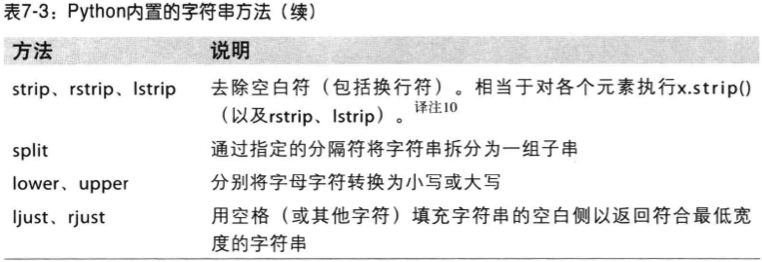
4.2 正则表达式
复习一下正则表达式
In [17]: import re
In [18]: text = 'foo bar\t baz \tqux'
In [19]: re.split('\s+', text) # \s+ 表示一个或多个空格
Out[19]: ['foo', 'bar', 'baz', 'qux']
In [20]: regex = re.compile('\s+') # 创建regex对象,多次复用,减少大量CPU时间
In [21]: regex.split(text)
Out[21]: ['foo', 'bar', 'baz', 'qux']
In [22]: regex.findall(text) # 所有text中匹配到的对象
Out[22]: [' ', '\t ', ' \t']
# match :从头开始匹配
# search:第一个
# findall:找到所有
In [23]: text = '''
...: Dave dave@google.com
...: Steve steve@gmail.com
...: Rob rob@gmail.com
...: Ryan ryan@yahoo.com
...: '''
In [24]: pattern = r'[A-Z0-9._%+-]+@[A-Z0-9.-]+\.[A-Z]{2,4}'
# flags=re.IGNORECASE 表示忽略大小写
In [25]: regex = re.compile(pattern, flags=re.IGNORECASE)
In [26]: regex.findall(text)
Out[26]: ['dave@google.com', 'steve@gmail.com', 'rob@gmail.com', 'ryan@yahoo.com']
In [27]: regex.search(text)
Out[27]: <_sre.SRE_Match at 0x104227b28>
In [29]: regex.search(text).group(0)
Out[29]: 'dave@google.com'
# sub 替换
In [30]: regex.sub('HAHAHA', text)
Out[30]: '\nDave HAHAHA\nSteve HAHAHA\nRob HAHAHA\nRyan HAHAHA\n'
In [31]: print(regex.sub("HAHAHAAHA", text))
Dave HAHAHAAHA
Steve HAHAHAAHA
Rob HAHAHAAHA
Ryan HAHAHAAHA
# 分组
In [33]: pattern = r'([A-Z0-9._%+-]+)@([A-Z0-9.-]+)\.([A-Z]{2,4})'
In [34]: regex = re.compile(pattern, flags=re.IGNORECASE)
In [35]: m=regex.match('wesm@bright.net')
In [36]: m.groups()
Out[36]: ('wesm', 'bright', 'net')
In [37]: m.group(0)
Out[37]: 'wesm@bright.net'
In [38]: m.group(1)
Out[38]: 'wesm'
In [39]: m.group(2)
Out[39]: 'bright'
In [40]: m.group(3)
Out[40]: 'net'
# 返回一个大的列表
In [41]: regex.findall(text)
Out[41]:
[('dave', 'google', 'com'),
('steve', 'gmail', 'com'),
('rob', 'gmail', 'com'),
('ryan', 'yahoo', 'com')]
# 指定替换
In [48]: regex.sub(r'Username:\1,Domain:\2,Suffix:\3',text)
Out[48]: '\nDave Username:dave,Domain:google,Suffix:com\nSteve Username:steve,Domain:gmail,Suffix:com\nRob Username:rob,Domain:gmail,Suffix:com\nRyan Username:ryan,Domain:yahoo,Suffix:com\n'
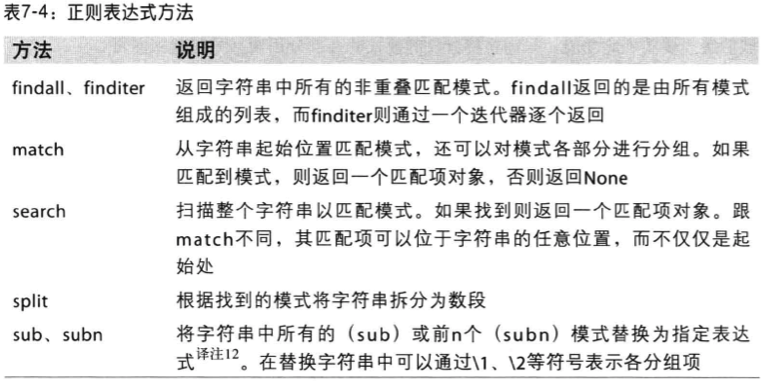
4.3 pandas矢量化的字符串函数
In [61]: data = {
...: 'Dave':'dave@google.com',
...: 'Steve':'steve@gmail.com',
...: 'Rob':'rob@gmail.com',
...: 'Ryan':'ryan@yahoo.com',
...: 'Wes':np.nan}
In [62]: data = Series(data)
In [63]: data
Out[63]:
Dave dave@google.com
Rob rob@gmail.com
Ryan ryan@yahoo.com
Steve steve@gmail.com
Wes NaN
dtype: object
In [64]: data.isnull()
Out[64]:
Dave False
Rob False
Ryan False
Steve False
Wes True
dtype: bool
# 查看是否包含,返回一个bool Series
In [65]: data.str.contains('gmail')
Out[65]:
Dave False
Rob True
Ryan False
Steve True
Wes NaN
dtype: object
In [66]: pattern
Out[66]: '([A-Z0-9._%+-]+)@([A-Z0-9.-]+)\\.([A-Z]{2,4})'
# 返回一个匹配好的Series
In [67]: data.str.findall(pattern, flags=re.IGNORECASE)
Out[67]:
Dave [(dave, google, com)]
Rob [(rob, gmail, com)]
Ryan [(ryan, yahoo, com)]
Steve [(steve, gmail, com)]
Wes NaN
dtype: object
In [68]: matches = data.str.match(pattern, flags=re.IGNORECASE)
/Users/yangfeilong/anaconda/bin/ipython:1: FutureWarning: In future versions of pandas, match will change to always return a bool indexer.
#!/bin/bash /Users/yangfeilong/anaconda/bin/python.app
In [69]: matches
Out[69]:
Dave (dave, google, com)
Rob (rob, gmail, com)
Ryan (ryan, yahoo, com)
Steve (steve, gmail, com)
Wes NaN
dtype: object
In [70]: matches.str.get(1)
Out[70]:
Dave google
Rob gmail
Ryan yahoo
Steve gmail
Wes NaN
dtype: object
In [71]: matches.str.get(2)
Out[71]:
Dave com
Rob com
Ryan com
Steve com
Wes NaN
dtype: object
In [72]: matches.str[0]
Out[72]:
Dave dave
Rob rob
Ryan ryan
Steve steve
Wes NaN
dtype: object
In [73]: data.str[:5]
Out[73]:
Dave dave@
Rob rob@g
Ryan ryan@
Steve steve
Wes NaN
dtype: object
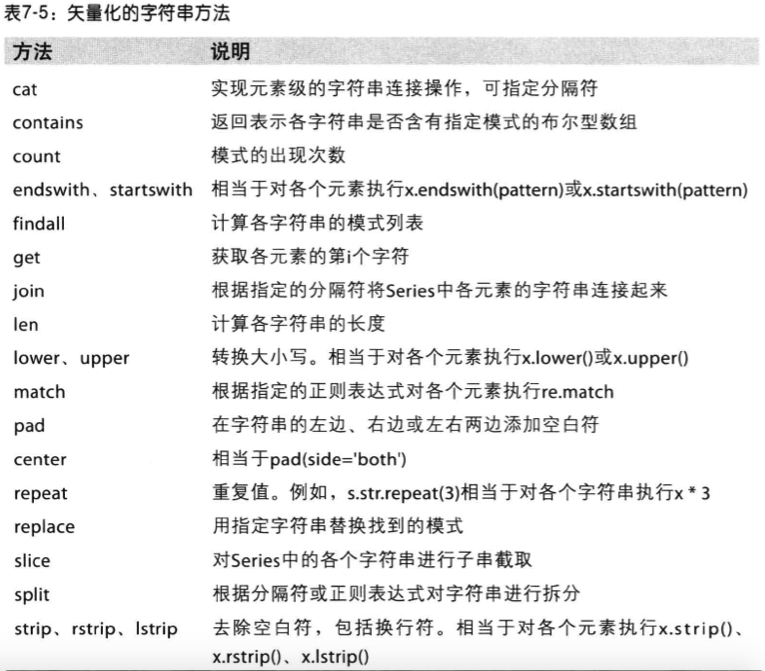
5 示例:usda食品数据库
本部分完。